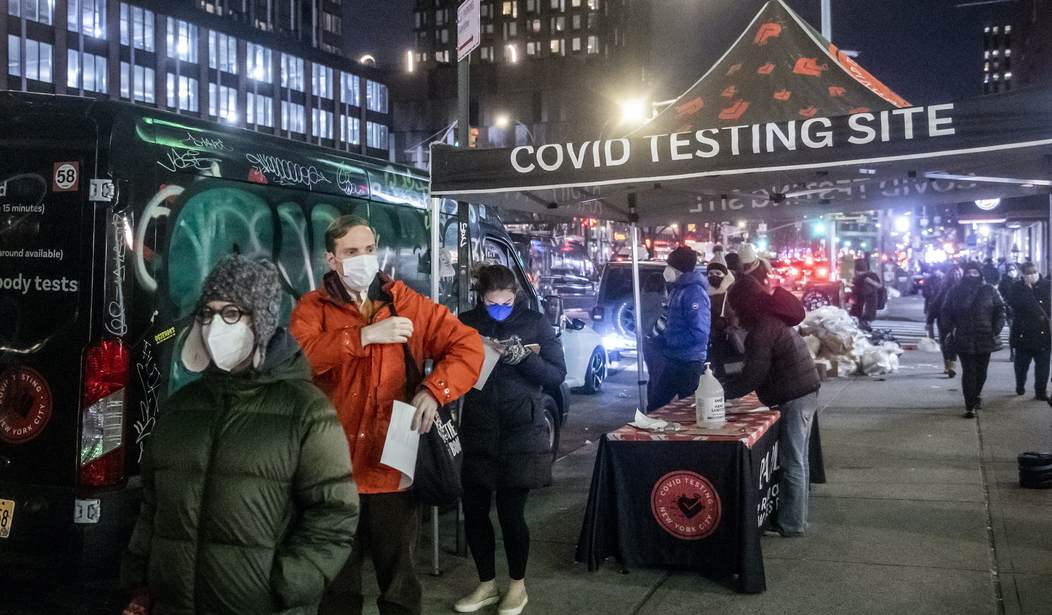Is America prepared for a new COVID-19 variant and the wave of infections it’s causing? Will vaccines hold up against it? More to the point, it’s already upon us … and doesn’t appear to be creating any new issues.
That’s not to say that everyone’s sanguine about it. The teachers-union leader that fought to keep schools closed for the better part of two years declared that “Covid isn’t over” (via Twitchy):
The arrival of subvariant BA.5 should be a reminder that Covid isn’t over. https://t.co/2AZQjqLpDG
— Randi Weingarten ☮️🇺🇦 (@rweingarten) July 8, 2022
The Washington Post editorial board declared that the arrival of the latest variant, Omicron BA.5, means that “the finish line in this race is nowhere to be seen”:
What’s BA.5? This is the latest subvariant of omicron, which stormed the planet late last year and caused a huge wave of infection. As of now, BA.5 and a closely related variant, BA.4, account for about 70 percent of all infections in the United States, according to estimates by the Centers for Disease Control and Prevention, based in part on modeling. These two newcomers are easing out an earlier variant, BA.2.
The obscure names should not hide the punch of BA.5. Eric Topol, professor of molecular medicine at Scripps Research, says that BA.5 “is the worst version of the virus that we’ve seen.” He adds, “It takes immune escape, already extensive, to the next level, and, as a function of that, enhanced transmissibility,” well beyond earlier versions of omicron. There has not been a marked increase in hospitalizations and deaths, he reports, because there is so much immunity built up from the winter omicron wave. But there are aspects of this new variant very much worth keeping an eye on as the United States remains stuck at an uncomfortably high plateau of pandemic misery. And the new variants are driving a case surge in Europe.
At the core of the BA.5 difference is its biology. Evolution has given it more fitness, a term that incorporates its ability to transmit, grow and evade immunity; the variant shows “marked difference from all prior variants,” reports Dr. Topol. One way it does so is by evading the body’s immune system, and BA.4 and BA.5 together are “the most immune-evasive variants” seen in multiple studies to date.
That does sound bad, but … what does it mean? Does that mean we’re going to see rapid escalations in health-care utilization? WaPo editors say that, um, actually … they don’t know:
Whether BA.5 will lead to more severe disease isn’t clear yet. But knowing that the virus is spreading should reinforce the need for the familiar mitigation measures: high-quality face masks, better air filtration and ventilation, and avoiding exposure in crowded indoor spaces.
Actually we can get a pretty good idea about whether this variant is causing more severe disease and outcomes. The data on that is readily available at the CDC website. BA.5 began circulating in the US two months ago along with BA.4, which combined account for about two-thirds of all COVID-19 diagnoses. If these variants caused more severe outcomes thanks to the ability to evade vaccine-induced and/or exposure-induced immunities, we’d see a big uptick in hospital utilization.
Instead, we see this, and bear in mind that this is correlated admissions rather than causative:

The rates of COVID-19-associated (correlative rather than causative) hospital admissions for adults nationwide and children in the Emerging Infections Program (EIP) states have barely budged over the last three months except among seniors above 65 years of age. Even that small rise — less than a third of the amplitude for that age demo in the Omicron wave at the beginning of the year — has begun to fade. And we don’t know how many, if any, of those admissions were due to actual COVID-19 complications, rather than for other issues with a coincidental previous exposure to a COVID-19 variant.
What about COVID-correlated deaths? Again noting that these are not COVID-caused deaths but rather deaths that also include a diagnosis of COVID-19, that rate hasn’t budged at all since mid-April:

Not only does it appear that BA.5 and BA.4 are not creating any health-care system pressure at the moment, it seems like it’s spreading much less than Omicron did in terms of correlated hospitalizations and deaths. We expect this metric to be a lagging indicator on COVID-variant strength, of course, and it might be too quick to write this off as yet. However, these variants have spread for a couple of months now, and they aren’t moving the amplitude of even correlated hospital admissions so far. So there’s no data at the moment that suggests that we will see a big spike in correlated deaths, let alone causative admissions and deaths.
That may be because we’re not seeing a large spike in diagnosed cases either. That metric did rise when the new variants entered the US, but it’s nowhere near the amplitude of Omicron and less than that of Delta as well:

I’m no epidemiologist, but then again, neither are Randi Weingarten and the WaPo editors. This data seems to indicate that BA.5 and BA.4 are having much less impact on the population than Omicron did, and that its impact on hospital utilization is minimal even in a correlative sense. It may even look a bit like the vaccines and exposure-related immunities are doing pretty well against BA.5 and BA.4, even if they’re not perfect against these variants — certainly a lot better than they held up against the original Omicron variant. Hence, while we may not know that these variants won’t “lead to more severe disease” yet, we don’t have any evidence that they do or they will. The evidence we do have points in the other direction of yet another round of Chicken Littleism, though.
Finally, Americans have had it with COVID Chicken Littleism. Variants will come and go, just as they do with the flu, which can also be lethal for vulnerable populations. We have to make sure we have the proper resources to deal with the inevitable outbreaks, but the idea that we need to live in a permanent emergency posture is not just unrealistic but unsupported by the data we have at present. That’s the kind of data presentation we used to expect from the media, but which has been sadly lacking for most of the past two-plus years.
This is not a pandemic any longer. It’s an endemic disease which we have to incorporate into our normal pattern of living, and quit freaking out unless the data makes it clear that freaking out is an absolute necessity.








Join the conversation as a VIP Member